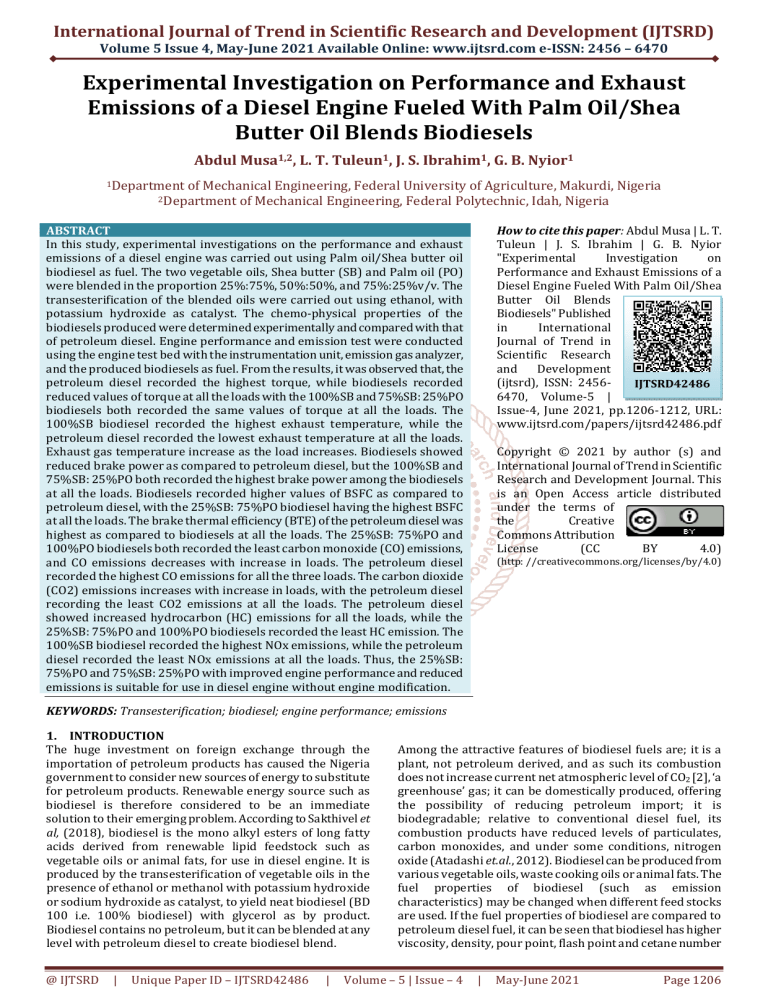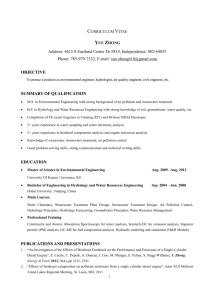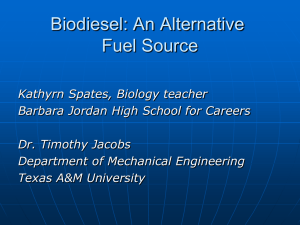
International Journal of Trend in Scientific Research and Development (IJTSRD)
Volume 5 Issue 4, May-June 2021 Available Online: www.ijtsrd.com e-ISSN: 2456 – 6470
Experimental Investigation on Performance and Exhaust
Emissions of a Diesel Engine Fueled With Palm Oil/Shea
Butter Oil Blends Biodiesels
Abdul Musa1,2, L. T. Tuleun1, J. S. Ibrahim1, G. B. Nyior1
1Department
of Mechanical Engineering, Federal University of Agriculture, Makurdi, Nigeria
of Mechanical Engineering, Federal Polytechnic, Idah, Nigeria
2Department
How to cite this paper: Abdul Musa | L. T.
Tuleun | J. S. Ibrahim | G. B. Nyior
"Experimental
Investigation
on
Performance and Exhaust Emissions of a
Diesel Engine Fueled With Palm Oil/Shea
Butter Oil Blends
Biodiesels" Published
in
International
Journal of Trend in
Scientific Research
and
Development
(ijtsrd), ISSN: 2456IJTSRD42486
6470, Volume-5 |
Issue-4, June 2021, pp.1206-1212, URL:
www.ijtsrd.com/papers/ijtsrd42486.pdf
ABSTRACT
In this study, experimental investigations on the performance and exhaust
emissions of a diesel engine was carried out using Palm oil/Shea butter oil
biodiesel as fuel. The two vegetable oils, Shea butter (SB) and Palm oil (PO)
were blended in the proportion 25%:75%, 50%:50%, and 75%:25%v/v. The
transesterification of the blended oils were carried out using ethanol, with
potassium hydroxide as catalyst. The chemo-physical properties of the
biodiesels produced were determined experimentally and compared with that
of petroleum diesel. Engine performance and emission test were conducted
using the engine test bed with the instrumentation unit, emission gas analyzer,
and the produced biodiesels as fuel. From the results, it was observed that, the
petroleum diesel recorded the highest torque, while biodiesels recorded
reduced values of torque at all the loads with the 100%SB and 75%SB: 25%PO
biodiesels both recorded the same values of torque at all the loads. The
100%SB biodiesel recorded the highest exhaust temperature, while the
petroleum diesel recorded the lowest exhaust temperature at all the loads.
Exhaust gas temperature increase as the load increases. Biodiesels showed
reduced brake power as compared to petroleum diesel, but the 100%SB and
75%SB: 25%PO both recorded the highest brake power among the biodiesels
at all the loads. Biodiesels recorded higher values of BSFC as compared to
petroleum diesel, with the 25%SB: 75%PO biodiesel having the highest BSFC
at all the loads. The brake thermal efficiency (BTE) of the petroleum diesel was
highest as compared to biodiesels at all the loads. The 25%SB: 75%PO and
100%PO biodiesels both recorded the least carbon monoxide (CO) emissions,
and CO emissions decreases with increase in loads. The petroleum diesel
recorded the highest CO emissions for all the three loads. The carbon dioxide
(CO2) emissions increases with increase in loads, with the petroleum diesel
recording the least CO2 emissions at all the loads. The petroleum diesel
showed increased hydrocarbon (HC) emissions for all the loads, while the
25%SB: 75%PO and 100%PO biodiesels recorded the least HC emission. The
100%SB biodiesel recorded the highest NOx emissions, while the petroleum
diesel recorded the least NOx emissions at all the loads. Thus, the 25%SB:
75%PO and 75%SB: 25%PO with improved engine performance and reduced
emissions is suitable for use in diesel engine without engine modification.
Copyright © 2021 by author (s) and
International Journal of Trend in Scientific
Research and Development Journal. This
is an Open Access article distributed
under the terms of
the
Creative
Commons Attribution
License
(CC
BY
4.0)
(http: //creativecommons.org/licenses/by/4.0)
KEYWORDS: Transesterification; biodiesel; engine performance; emissions
1. INTRODUCTION
The huge investment on foreign exchange through the
importation of petroleum products has caused the Nigeria
government to consider new sources of energy to substitute
for petroleum products. Renewable energy source such as
biodiesel is therefore considered to be an immediate
solution to their emerging problem. According to Sakthivel et
al, (2018), biodiesel is the mono alkyl esters of long fatty
acids derived from renewable lipid feedstock such as
vegetable oils or animal fats, for use in diesel engine. It is
produced by the transesterification of vegetable oils in the
presence of ethanol or methanol with potassium hydroxide
or sodium hydroxide as catalyst, to yield neat biodiesel (BD
100 i.e. 100% biodiesel) with glycerol as by product.
Biodiesel contains no petroleum, but it can be blended at any
level with petroleum diesel to create biodiesel blend.
@ IJTSRD
|
Unique Paper ID – IJTSRD42486
|
Among the attractive features of biodiesel fuels are; it is a
plant, not petroleum derived, and as such its combustion
does not increase current net atmospheric level of CO2 [2], ‘a
greenhouse’ gas; it can be domestically produced, offering
the possibility of reducing petroleum import; it is
biodegradable; relative to conventional diesel fuel, its
combustion products have reduced levels of particulates,
carbon monoxides, and under some conditions, nitrogen
oxide (Atadashi et.al., 2012). Biodiesel can be produced from
various vegetable oils, waste cooking oils or animal fats. The
fuel properties of biodiesel (such as emission
characteristics) may be changed when different feed stocks
are used. If the fuel properties of biodiesel are compared to
petroleum diesel fuel, it can be seen that biodiesel has higher
viscosity, density, pour point, flash point and cetane number
Volume – 5 | Issue – 4
|
May-June 2021
Page 1206
International Journal of Trend in Scientific Research and Development (IJTSRD) @ www.ijtsrd.com eISSN: 2456-6470
near zero aromatic compound, and no sulphur link [4]. The
main aim of this study is to investigate the performance and
exhaust emission of a diesel engine fueled with novel
biodiesels produced and characterized from palm oil (PO),
shea butter oil (SB), and their blends (SB/PO). The choice of
these oils for evaluation came as a result of their abundant
availability, and also to determine if their performances
would present them as suitable candidate fuels to replace or
compliment petroleum-based diesel fuel.
2. Materials and Methods
2.1. Materials/equipment
The Palm oil and Shea butter oil feed stocks used were
purchased from Anyigba market in Kogi State, Nigeria. The
chemo-physical properties of the oils and biodiesels were
determined using ethanol (99/100. M.W.46.07), Diethyl
ether (M.W 7412g/mol.), Sodium hydroxide (0.1mol. M.W
40.00. 98.9%), Phenolphthalein solution, Isopropanol
(60.10g/mol), thermometer, and Weighing balance of model
PM 2500. Absolute ethanol (99/100%), and potassium
hydroxide were used as the alcohol and catalyst respectively,
during the transesterification process. The equipment used
for the biodiesel production were Rotary stirrer/magnet
(DF-II Heating stirrer), weighing balance (PM 2500), and
separating funnels (500ml). The engine test bed and
emission gas analyzer model (SLFA-20) were used for
determination of the performance and emission
characteristics of the biodiesels.
2.2. Methods
2.2.1. Preparation of the vegetable oil samples
The two vegetable oils were heated to 1000C for 15 minutes,
and filtered to remove moisture and impurities. The oils
were blended in different volume proportions as follows:
25% Shea butter: 75% Palm oil (25%SB: 75%PO); 50% Shea
butter: 50% Palm oil (50%SB: 50%PO), and 75% Shea
butter: 25% Palm oil (75%SB: 25%PO).
2.2.2. Biodiesel production and characterization
The first step of the production process is the weighing of
each of the oil samples and alcohol in the ratio 1:6 using a
digital weighing balance, (Musa, 2016). For each of the
weight ratio, 1% of catalyst (weight of oils) were weighed.
The catalyst was dissolved in the alcohol using a magnetic
stirrer. The mixture of alcohol and catalyst (ethoxide) was
poured into the oil and the first transesterification process
was started. With the aid of the magnetic stirrer and magnet,
the mixture was stirred for 60 minutes at a temperature of
450C. At the end of the reaction time, the mixture was
transferred into a separating funnel, where it was allowed to
settle, and then separated into two layers (biodiesel and
glycerol). The lower denser one was the glycerol, while the
upper one was the biodiesel. The glycerol was decanted and
the ester (biodiesel) was removed for washing.
The dry purification method was used in the washing of the
biodiesel. This involves the use of inorganic matrices
(Magnesium silicate) as adsorbents in the biodiesel
purification process. The crude biodiesel was heated and
stirred slowly until reaching 650C. At this point, 2% (m/m) of
the adsorbent (Magnesium silicate), related to the mass of
biodiesel, was added and maintained at 650C and stirring for
25 minutes. The biodiesel was then allowed to settle and was
filtered to remove the adsorbent and then stored for further
analysis. This methods was in line with the work of (Ouanji
et al., 2016), on biodiesel production at small scale for local
@ IJTSRD
|
Unique Paper ID – IJTSRD42486
|
power generation. The process was repeated for the
remaining oil blends. The chemo-physical properties of the
biodiesel samples were determined experimentally and was
compared with that of the petroleum diesel as shown in
Table 2.
2.2.3. Engine performance and emissions
A. Engine Performance evaluation
The performance evaluation of the biodiesels was carried
out using engine test bed and the instrumentation units. The
specification of the engine test bed and the instrumentation
unit is presented in Table 1. The experiment was carried out
by running the engine test bed on the biodiesel samples at
different loads. For each of the biodiesel tested, the engine
was run at different times on three different loads (500kg,
1500kg, and 2500kg), at a constant speed of 2500 revolution
per minutes. During each of the test, the torque, exhaust gas
temperature, and time were recorded. Other parameters
such as; brake power, brake specific fuel consumption, and
brake thermal efficiency were calculated using equations (5),
(6a), (6b) and (7) respectively. The procedures was repeated
for other biodiesels samples produced and petroleum diesel.
Pb=2πN60×T (5)
Where N= Revolution per minute of the engine
T = Torque (Nm)
BSFC=mf10-3Pb (gKwh)
(6a)
Where mf = mass flow rate
Pb = brake power, and
mf= Sgf ×1000×8×10-6t (kgs)
(6b)
Where Sgf = specific gravity of the fuel
t = time in seconds
b= PbmfCv
(7)
Where Cv = Calorific value of the fuel
Table 1: Specifications of the Diesel Engine Test Bed
S/N
Characteristics
Specifications
1.
Engine type
TD 114
2.
Number of strokes
Four strokes
3.
Number of cylinders
1 cylinder
4.
Engine power range
2.5- 7.5
5.
Maximum torque
15 Nm
6.
Maximum speed
600 rpm
7.
Swept volume
195cc
Eddy current, water
8.
Dynamometer type
cooled, with loading unit
B. Emissions determination
The procedures for the determination of the emission
characteristics involved running the engine test bed using
biodiesel as fuel, as described in section (2.2.1) above. The
emission gas analyzer (EGA), was connected to power
source, and the sensor was connected to the engine test bed
through the exhaust pipe. So, as the engine ran on the
different biodiesels at different loads, the amount of gaseous
emissions; (carbon monoxide (CO), carbon dioxide (CO2),
hydrocarbon (HC), and nitrogen oxide (NOx)) from the
exhaust were read from the EGA, when the reading on the
screen became stable. The procedures was repeated for
other biodiesels samples produced, and the petroleum
diesel.
Volume – 5 | Issue – 4
|
May-June 2021
Page 1207
International Journal of Trend in Scientific Research and Development (IJTSRD) @ www.ijtsrd.com eISSN: 2456-6470
3. Results and discussion
3.1. Chemo-physical analysis of the biodiesels
The results of the chemo-physical properties of the biodiesels produced from Palm oil, Shea butter and their blends and that of
the petroleum diesel is presented in Table 2.
Sample
No.
ASTM
D 6751
1.
2.
3.
4.
5.
6.
Table 2: Chemo-Physical Analysis of the Biodiesel and Petroleum Diesel
Kinematic
% Free
Flash
Fire
Iodine
Carbon
Sample
Viscosity @
Density
fatty
point point
value
Residue
0
3
Code
40 C, 60
(Kg/m )
acid
(0C)
(0C)
(gI2/100g)
(%vol.)
rpm (mpa.s)
(%)
0.02 max.
1.9 - 6.0
>130
(% vol.).
25% SB:
5.15
871
0.486
164
188
134
0.031
75% PO
50% SB:
5.40
874
0.512
167
190
136
0.034
50% PO
75% SB:
5.45
878
0.538
169
193
137
0.038
25% PO
100% SB
5.50
881
0.564
171
195
138
0.041
100% PO
5.30
867
0.460
162
185
133
0.027
Petro-diesel
3.5
820
60
80
8.5
0.060
Moisture
content
(%vol.)
0.05 max
(% vol.).
0.0714
0.0882
0.0798
0.0728
0.0987
0.0150
3.2. Engine performance evaluation
The results of the engine performance test on the biodiesels produced, and that of the petroleum diesel are reported and
discussed in this section. shown in Figure 1-5 below.
3.2.1.
Torque: Figure 1 showed the variation of torque with loads for the Shea butter/Palm oil blends (SB/PO) biodiesel
samples.
Figure1: Variation of loads with torque for the biodiesels and petroleum diesel.
From the plots, the 100%PO biodiesel recorded the same torque with the 25%SB: 75%PO. It was observed that, torque
increase as loads increases. The torque values obtained for the biodiesels and petroleum diesel agreed with the work of (Stalin
and Prabhu, 2007); and [8]. The authors reported that, torque increases as engine loads increases and that, the petroleum
diesel recorded higher torque as compared to the biodiesels. The implication of these results is that, the petroleum diesel
produced the highest calorific values, as increase in calorific value leads to increase in torque, as reported by Stalin and Prabhu,
(2007). Biodiesels with torque values close to that of the petroleum diesel is best suitable for diesel engine, as too low calorific
value will produce very low torque.
3.2.2.
Exhaust gas temperature: Figure 2 showed the variation of exhaust gas temperature with loads for the Shea
butter/Palm oil blends (SB/PO) biodiesel samples.
Figure 2: Variation of loads with exhaust temperature for biodiesels and petroleum diesel.
@ IJTSRD
|
Unique Paper ID – IJTSRD42486
|
Volume – 5 | Issue – 4
|
May-June 2021
Page 1208
International Journal of Trend in Scientific Research and Development (IJTSRD) @ www.ijtsrd.com eISSN: 2456-6470
From the results, it was observed that, the Petroleum diesel recorded the lowest exhaust gas temperature at all the loads. The
exhaust gas temperature of the biodiesels did not show much variance, but that of the 100%PO is lower. The results obtained
for exhaust gas temperature of the biodiesel samples agreed with the work of [9]; and [10]. The authors concluded that, the
exhaust gas temperature increases as the engine load increases, and comparing with Petroleum diesel, biodiesel recorded
higher exhaust gas temperature. This is due to higher viscosity and poor volatility of biodiesel, and because of higher oxygen
content in biodiesel, it has improved combustion which can also leads to higher temperature as reported by Gnanasekaran,
(2016).
3.2.3.
Brake power: Figure 3 depicts the variation of brake power with loads for the Shea butter/Palm oil blends (SB/PO)
biodiesel samples.
Figure 3: Variation of loads with brake power for biodiesels and petroleum diesel.
From the results, it was observed that, the brake power increase as the load increases. The petroleum diesel recorded the
highest brake power at all the loads, while the 100%SB and 75%SB: 25%PO both recorded the highest brake power at all the
loads. The 100%PO and the 25%SB: 75%PO also recorded the same brake power at all the three loads. The results obtained for
the brake power is in line with the work of Kumar et al., (2015), and (Stalin and Prabhu, 2007). The authors reported that,
brake power is a function of calorific values and the torque applied, and that, brake power increases with increase in load. The
implication of these results is that, since brake power is a function of calorific value, the petroleum diesel has the highest
calorific value. Biodiesels with high brake power can be recommended for use in diesel engine without engine modification.
3.2.4.
Brake Specific Fuel Consumption (BSFC): Figure 4 depicts the variation of BSFC with loads for the Shea butter/Palm
oil blends (SB/PO) biodiesel samples.
Figure 4: Variation of loads with brake specific fuel consumption for biodiesels and petroleum diesel.
From the experiment, it was found that, the 25%SB: 75%PO biodiesel recorded the highest BSFC of 0.4kg/kw.hr at load 500kg,
the 50%SB: 50%PO biodiesel recorded the highest BSFC at load 1500kg, and the 100%PO biodiesel recorded the highest at
load 2500kg. The petroleum diesel recorded the lowest BSFC at all the loads. It was observed that, the BSFC decreases as the
engine loads increases. The obtained BSFC values for the biodiesel samples and petroleum diesel agreed with the works of [7];
(Kumar et al., 2015); (Gnanasekaran, 2016); and [12]. The authors reported that, the BSFC decreases with increase in load, and
that BSFC increases as the biodiesel content of fuel blends increases. The obtained results implied that, biodiesels has the
highest BSFC as compared to petroleum diesel, and this could be due to high heating value and low density of the petroleum
diesel as reported by [12]
3.2.5.
Brake thermal efficiency (BTE): The brake thermal efficiency (BTE) is an indication of the efficiency of conversion of
the chemical energy of the fuel to work [10]. Figure 5 depicts the variation of BTE with loads for the Shea butter/Palm
oil blends (SB/PO) biodiesel samples.
@ IJTSRD
|
Unique Paper ID – IJTSRD42486
|
Volume – 5 | Issue – 4
|
May-June 2021
Page 1209
International Journal of Trend in Scientific Research and Development (IJTSRD) @ www.ijtsrd.com eISSN: 2456-6470
Figure 5: Variation of loads with brake thermal efficiency for biodiesels and petroleum diesel.
Based on the results (Figure 5), the 25%SB: 75%PO biodiesel recorded the lowest BTE of 22.90% at load 500kg, but the
50%SB:50%PO biodiesel recorded the lowest BTE of 37.10% and 49.70% at loads 1500kg and 2500kg respectively. The
petroleum diesel recorded the highest BTE at all the loads. It was observed that, the BTE increases with increase in load. The
trends in the BTE values of the biodiesel samples and that of the petroleum diesel were in agreement with the work of [7]; [12],
and [9]. The authors reported that, the brake thermal efficiency of petroleum diesel is higher than that of biodiesel fuels. The
reasons for this could be due to higher kinematic viscosity, density, low volatility and low heating values of biodiesels as
compared to petroleum diesel.
3.3. Emission characteristics of the biodiesels
The SB/PO biodiesel samples and petroleum diesel were run in a four strokes, water cooled, compression ignition engine on
three different loads (500kg, 1500kg, and 2500kg), and the emission results are presented in Table 3.
Table 3: Emission characteristics of the biodiesels and petroleum diesel.
Sample No.
Sample Code
Loads (Kg) CO (%) CO2 (%) HC (ppm) NOx (ppm)
500
0.11
2.08
112
160
1.
25% SB: 75%PO
1500
0.09
2.09
110
229
2500
0.07
2.14
109
279
500
0.12
2.09
114
165
2.
50%SB: 50%PO
1500
0.10
2.11
112
233
2500
0.08
2.15
110
283
500
0.13
2.11
115
170
3.
75%SB: 25%PO
1500
0.11
2.13
112
236
2500
0.09
2.16
111
287
500
0.13
2.12
115
174
4.
100%SB
1500
0.10
2.14
113
240
2500
0.09
2.16
111
290
500
0.12
2.06
114
156
5.
100%PO
1500
0.09
2.08
110
225
2500
0.07
2.14
109
275
500
1.12
1.02
128
88
6.
Petro-diesel
1500
1.10
1.04
125
145
2500
1.08
1.07
123
198
(i) Carbon monoxide (CO) emissions: The carbon
monoxide (CO) emissions decreases with increase in loads,
and the petroleum diesel has the highest CO emissions of
1.12%, 1.10% and 1.08% at load 500kg, 1500kg, and 2500kg
respectively. Among the biodiesel samples, the 75% Shea
butter oil-to-25% Palm oil (75%SB:25%PO), and the pure
Shea butter (100%SB) biodiesels both gave the highest
emissions of 0.13% at load of 500kg, while the
25%SB:75%PO and 100%PO both recorded the least CO
emissions of 0.09% and 0.07% at the loads 1500kg and
2500kg respectively.
The trends in the CO emissions of biodiesel and petroleum
diesel is in agreement with the work of [9]; and [10]. The
authors concluded that, petroleum diesel has higher CO
emissions as compared to biodiesel fuels, and that, CO
emissions decreases with increase in the load. The higher CO
emissions of petroleum diesel is due to the low oxygen
@ IJTSRD
|
Unique Paper ID – IJTSRD42486
|
content of the fuel. The (CO) is a toxic gas formed due to the
incomplete combustion of any fuel which does not contain
oxygen, and factors, such as engine speed, engine loads, airfuel ratio, injection pressure, injection timing and type of fuel
used have an effect on CO emission (Kumar et al., (2016).
The results implied that, the 25%SB: 75%PO and 100%PO
biodiesels with the lowest CO emissions has the highest
oxygen content for complete combustion.
(ii) Carbon dioxide (CO2) emissions: The carbon dioxide
(CO2) emissions, were seen to have increased with increase
in load. The petroleum diesel recorded the lowest CO2
emission values of 1.02%, 1.04%, and 1.07%, at load 500kg,
1500kg, and 2500kg respectively. Among the biodiesels, the
100%SB and 75%SB: 25%PO recorded the highest CO2
emissions of 2.16% at the load of 2500kg, while the 100%B
recorded the lowest CO2 emissions of 2.06% at the load of
500kg. The trends in the CO2 emissions of biodiesels and
Volume – 5 | Issue – 4
|
May-June 2021
Page 1210
International Journal of Trend in Scientific Research and Development (IJTSRD) @ www.ijtsrd.com eISSN: 2456-6470
petroleum diesel agreed with the work of (Kumar et al.,
2015); and [9]. The authors reported that, CO2 increases as
the loads increases, and that, the CO2 emissions of biodiesel
fuels are always higher than that of the petroleum diesel. The
reasons for this was attributed to higher oxygen content of
biodiesels. The implication of these results is that, the
100%SB and 75%SB: 25%PO biodiesels burnt completely
due to their highest oxygen content as compared to other
biodiesels.
(iii) Hydrocarbon (HC) emission: The hydrocarbon (HC)
emissions of the biodiesels and petroleum diesel are as
presented in Table 3. The HC emissions of the biodiesels
varies from (109 - 115) ppm. Among the biodiesel fuels, the
75%SB:25%PO, and 100%PO biodiesels all recorded the
highest HC emissions of 115ppm at load 500kg, while the
25%SB:75%PO and the 100%PO biodiesels recorded the
least HC emissions of 109ppm at load 2500kg. The
petroleum diesel recorded the overall highest HC emissions
of 128ppm, 125ppm and 123ppm at loads 500kg, 1500kg,
and 2500kg respectively. It was also observed that, the HC
emissions decreases as the load increases. The trends in the
HC emissions of biodiesels and petroleum diesel were in line
with the work of (Kumar et al., 2015); [9]; and [10]. The
authors concluded that, petroleum diesel generate more HC
emissions at all loading conditions, as compared to biodiesel
fuel, and that HC emissions decreases with increase in the
loads. The reasons are that, the higher oxygen content of
biodiesel resulted in improved combustion, thereby leading
to reduced HC emissions. At higher loads, HC emission is
reduced due to the fact that, increased loads improved fuel
atomization which enhanced complete combustion and
reduces the HC emissions. The results obtained implied that,
the 25%SB: 75%PO and the 100%PO biodiesels having the
least HC emissions will be friendlier to the environment as
compared to the petroleum diesel, because of its effects on
human respiratory system.
(iv) Nitrogen oxide (NOx) emissions: The nitrogen oxide
(NOx) emissions of the biodiesels and petroleum diesel are
presented in Table 3. The nitrogen oxide emissions (NOx) of
the biodiesels varied from (156 – 290) ppm, with the
100%SB having the highest value of 290ppm at load 2500kg,
while the 100%PO biodiesel recorded the lowest NOx
emissions of 156ppm at load 500kg. From the results, it was
generally observed that, the biodiesel fuels recorded higher
NOx emissions for all the three loads, as compared to
petroleum diesel, and the NOx emissions increases with
increase in the loads. The results obtained for the NOx
emissions for the biodiesels and petroleum diesel were in
agreement with the work of Gandhi, (2016). The author
reported that, nitrogen oxide emission was higher by
29.37% for biodiesel as compared to petroleum diesel. Since
high temperature and availability of oxygen are the two main
factors that affects NOx formation, the results implied that,
biodiesels with higher amount of oxygen will produce higher
amount of NOx. And at higher loads, the cylinder
temperature is increased causing the fuel to burn completely
thereby generating higher amount of NOx emissions as
reported by [12].
4. Conclusions
Biodiesels were produced by transesterification of Palm
oil/Shea butter oil blends and alcohol in the presence of
potassium hydroxide (KOH) as catalyst. The performance
and emission characteristics were investigated for a
@ IJTSRD
|
Unique Paper ID – IJTSRD42486
|
stationary engine, and the following conclusions were
drawn.
1.
Engine performance parameters such as, torque, brake
power, and brake thermal efficiency were seen to be
highest for petroleum diesel as compared to biodiesels,
while the exhaust gas temperature, and brake specific
fuel consumption were higher for biodiesels as
compared to petroleum diesel.
2.
All the biodiesels (25%SB: 75%PO, 50%SB: 50%PO,
75%SB: 25%PO, 100%SB and 100%PO) exhibited
reduction in exhaust emissions of CO and HC, except for
the CO2 and NOx.
References
[1] R. Sakthivel, K. Ramesh, R. Purnachandran, and P. M.
Shameer, “A review on the properties, performance
and emission aspects of the third generation
biodiesels,” Renew. Sustain. Energy Rev., vol. 82, no. 5,
pp. 2970–2992, 2018.
[2]
A. Sudrajat, N. Tamaldin, A. K. M. Yamin, M. F. Bin
Abdollah, M. H. Zakaria, and G. Nyirenda,
“Performance analysis of biodiesel engine by addition
of HHO gas as a secondary fuel,” J. Tribol., vol. 26, no.
July, pp. 120–134, 2020.
[3]
I. M. Atadashi, M. K. Aroua, A. R. A. Aziz, and N. M. N.
Sulaiman, “Production of biodiesel using high free
fatty acid feedstocks,” Renew. Sustain. Energy Rev., vol.
16, no. 5, pp. 3275–3285, 2012.
[4]
C. Ghenai, “Combustion and Emissions Characteristics
of Biodiesel Fuels,” in Renewable Energy-Trends and
Applications, InTech, 2011.
[5]
I. A. Musa, “The effects of alcohol to oil molar ratios
and the type of alcohol on biodiesel production using
transesterification process,” Egypt. J. Pet., pp. 0–10,
2016.
[6]
F. Ouanji, M. Kacimi, M. Ziyad, and F. Puleo,
“ScienceDirect Production of biodiesel at small-scale (
10 L ) for local power generation,” Int. J. Hydrogen
Energy, no. 10 L, pp. 1–8, 2016.
[7]
N. Stalin and H. J. Prabhu, “PERFORMANCE TEST OF
IC ENGINE USING KARANJA BIODIESEL BLENDING
WITH DIESEL,” vol. 2, no. 5, pp. 2006–2008, 2007.
[8]
A. Shirneshan, B. Hosseinzadeh, and B. Ghobadian,
“Optimization of biodiesel percentage in fuel mixture
and engine operating conditions for diesel engine
performance and emission characteristics by Artificial
Bees Colony Algorithm,” Fuel, vol. 184, no. x, pp. 518–
526, 2016.
[9]
S. Gnanasekaran, “Prediction of CI engine
performance,
emission
and
combustion
characteristics using fish oil as a biodiesel at different
injection timing using fuzzy logic,” Fuel, vol. 183, pp.
214–229, 2016.
[10]
G. Dhamodaran, R. Krishnan, Y. Kutti, H. Machgahe, H.
Sivasubramanian, and A. Krishna, “A comparative
study of combustion, emission, and performance
characteristics of rice-bran-, neem-, and cottonseedoil biodiesels with varying degree of unsaturation,”
Fuel, vol. 187, pp. 296–305, 2017.
Volume – 5 | Issue – 4
|
May-June 2021
Page 1211
International Journal of Trend in Scientific Research and Development (IJTSRD) @ www.ijtsrd.com eISSN: 2456-6470
[11]
A. R. Kumar, G. J. Raju, and K. H. Reddy, “Emission and
Performance Characteristics of Diesel Engine Using
Mamey Sapote Biodiesel as,” vol. 3, no. Vii, pp. 289–
298, 2015.
[12]
S. Srinivasan, N. Kinnal, G. Sujaykumar, J.
Jayaprabakar, B. Dey, and K. Dey, “Comparative study
of performance and emissions of a CI engine using
biodiesel of microalgae, macroalgae and rice bran
Comparative study of performance and emissions of a
CI engine using biodiesel of microalgae, macroalgae
and rice,” 2017.
@ IJTSRD
|
Unique Paper ID – IJTSRD42486
|
[13]
A. Kumar, M. Emran, A. Manas, and A. Pal, “Case
Studies in Thermal Engineering Performance and
emission characteristics of a transportation diesel
engine operated with non-edible vegetable oils
biodiesel,” Case Stud. Therm. Eng., vol. 8, pp. 236–244,
2016.
[14]
V. C. S. Gandhi, “Performance and Emission Study of
Sardine Fish Oil Biodiesel in a Diesel PerforMance and
e Mission study of sardine fish oil Biodiesel in a diesel
engine,” no. January 2014, 2016.
Volume – 5 | Issue – 4
|
May-June 2021
Page 1212






